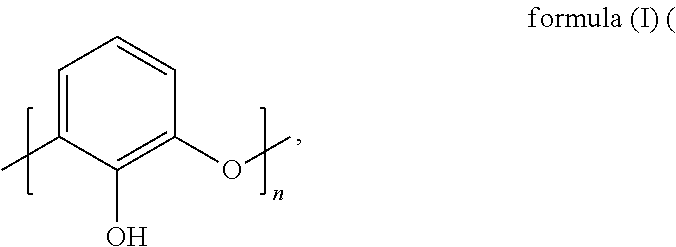Composition for preparing artificial graphite element, powdery material, and method for fabricating the element
- Summary
- Abstract
- Description
- Claims
- Application Information
AI Technical Summary
Benefits of technology
Problems solved by technology
Method used
Image
Examples
example 1
[0026]95 g of fuel fly ash, 5 g of natural graphite powder, 50 g of a novolac resin of
wherein n is an integer ranging from 500 to 1000) and 30 g of ethanol were thoroughly mixed in a mixing tank, and then the mixture was baked at 80° C. for 2 hours to remove thanol. Then, a Tyler sieve with an inner diameter Φ210×H45 mm and an oscillator (model no. LS-450A) were used to perform screening for selection, so as to obtain a plurality of particles having particle diameter sizes ranging from 150 to 500. Immediately after, the plurality of particles were pressed at a pressure condition of 40 tons to be molded into an article, by using a powder metallurgic molding machine (model no. PT-60). Then, under nitrogen, the article was heated at 700° C. for 2 hours to remove the novolac resin. Then, the article was graphitized at 2500° C. for 3 hours in a vacuum graphitization furnance (model no. JR-350) under argon. After cooling, the artificial graphite element was obtained. The wet density and p...
example 2
[0027]90 g of fuel fly ash, 10 g of natural graphite powder, 50 g of the novolac resin of formula (I) and 30 g of ethanol were thoroughly mixed in a mixing tank, and then the mixture was baked at 80° C. for 2 hours to remove thanol. Then, a Tyler sieve with an inner diameter Φ 210×H45 mm and an oscillator (model no. LS-450A) were used to perform screening for selection, so as to obtain a plurality of particles having particle diameter sizes ranging from 150 to 500. Immediately after, the plurality of particles were pressed at a pressure condition of 40 tons to be molded into an article, by using a powder metallurgic molding machine (model no. PT-60). Then, under nitrogen, the article was heated at 700° C. for 2 hours to remove the novolac resin. Then, the article was graphitized at 2500° C. for 3 hours in a vacuum graphitization furnance (model no. JR-350) under argon. After cooling, the artificial graphite element was obtained. The wet density and porousity of the artificial graphi...
example 3
[0028]The steps in Example 1 were repeated, except that 100 g of fuel fly ash, 55 g of the novolac resin of formula (I) and 30 g of ethanol were used for mixing in this example. Further, in this example, no natural graphite was added.
TABLE 1Example1Example 2Example 3Wet density1.5001.5061.544Porosity34.42730.41636.501
PUM
| Property | Measurement | Unit |
|---|---|---|
| Temperature | aaaaa | aaaaa |
| Temperature | aaaaa | aaaaa |
| Temperature | aaaaa | aaaaa |
Abstract
Description
Claims
Application Information
 Login to View More
Login to View More - R&D
- Intellectual Property
- Life Sciences
- Materials
- Tech Scout
- Unparalleled Data Quality
- Higher Quality Content
- 60% Fewer Hallucinations
Browse by: Latest US Patents, China's latest patents, Technical Efficacy Thesaurus, Application Domain, Technology Topic, Popular Technical Reports.
© 2025 PatSnap. All rights reserved.Legal|Privacy policy|Modern Slavery Act Transparency Statement|Sitemap|About US| Contact US: help@patsnap.com

